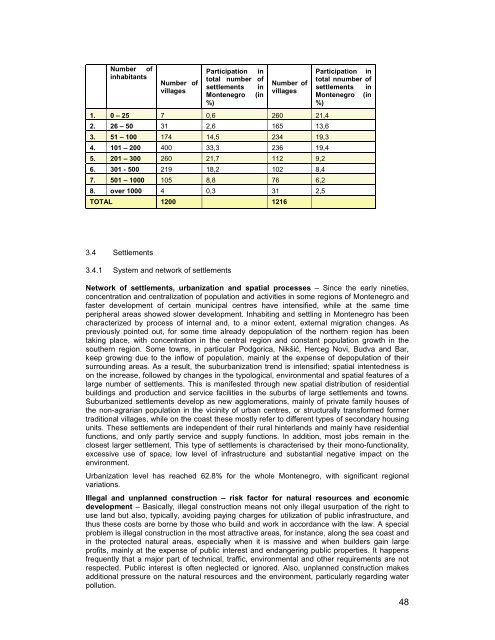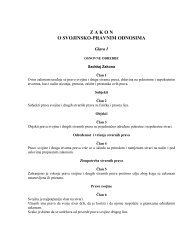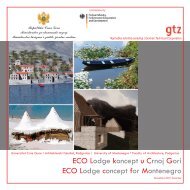As for the economic structure <strong>of</strong> the population, the prevailing category is active population,which makes 42.62% (2003), then the supported population – 40.58%, while the persons withtheir own income make 16.48% <strong>of</strong> the overall population. Within the active population, farmersparticipate with 8.86%. 3The population structure by education level had the fastest transformation compared to otherstructures and their changes, particularly relating to population with higher levels <strong>of</strong> education(secondary and higher). The share <strong>of</strong> population with university degrees increased from 5%(1991) to 7.5% in 2003, with college degree from 3.8% to 5.09%, while the share <strong>of</strong> populationwho graduated at secondary schools increased from 34.9% to 48.44%. Illiteracy rate decreasedfrom 5.6% (1991) to 2.5% in 2003.3.3.3 Main demographic problemsRegarding demographic problems, several essential factors may be stated:− The increase <strong>of</strong> the total number <strong>of</strong> inhabitants in <strong>Montenegro</strong> continued, but at a slowerrate;− Previously noted decrease in population increment continued due to the abrupt increase<strong>of</strong> mortality rate. As a result <strong>of</strong> such a situation there is a decrease <strong>of</strong> vital index (from2.852 in 1980 to 1.458 in 2003, or 1,95 times lower);− Decrease in the number <strong>of</strong> people getting married. At the same time, there is an increasein the number <strong>of</strong> divorces (4.1 per family member according to census in 1981, 3.7 in1991, 3.5 in 2003);− There has been a migration <strong>of</strong> the younger population from rural into urban areas, andvice versa in the case <strong>of</strong> older population. This has lead to the changed structure <strong>of</strong>settlements. Out <strong>of</strong> the total <strong>of</strong> 1,256 settlements, there were 28 (2, 23%) unpopulatedsettlements, 100 settlements (7.96%) with less than 10 inhabitants, 175 (13.93%)settlements with 10 to 30 inhabitants, 123 (9,79%) settlements with 30 to 50 inhabitantsand 23.486 settlements (18,63%) with 50 to 100 inhabitants. There were 596 settlements(47.45%) with more than 100 inhabitants.− In the majority <strong>of</strong> municipal centres, the number <strong>of</strong> inhabitants increased: Andrijevica(15%) Bar (27.2%) Budva (51.5%) Danilovgrad (16.1%) Žabljak (5%), Kolašin (19.8%)Nikšić (4.9%) Plužine (2.8%) Pljevlja (6.8%) Podgorica (17.5%) Rožaje (3.8%) Tivat(16.2%) Ulcinj (8.3%) and Herceg Novi (13.1%). Other municipal centres, Berane, BijeloPolje, Kotor, Mojkovac, Plav, Cetinje and Šavnik had the decrease <strong>of</strong> population;− The trend <strong>of</strong> migrations from the northern to the southern region continued, and thuseach coastal municipality has a positive migrations balance except Ulcinj. Positivemigration balance is also characteristic for the municipalities <strong>of</strong> Podgorica andDanilovgrad. The municipality <strong>of</strong> Plav also records a slight positive balance;− The trend <strong>of</strong> population aging continued;− Further depopulation <strong>of</strong> rual areas (see table 6).Table 6 – Comparative overview <strong>of</strong> village categories by number <strong>of</strong> inhabitants (1948/2003)Villag1948 2003.3 According to 1991 census, the participation <strong>of</strong> active population was 40.1%, supported population 47.26%, whilepersons with their own income participated with 12.6%. The participation <strong>of</strong> farmers was 9.38%.47
Number <strong>of</strong>inhabitantsNumber <strong>of</strong>villagesParticipation intotal number <strong>of</strong>settlements in<strong>Montenegro</strong> (in%)Number <strong>of</strong>villages1. 0 – 25 7 0,6 260 21,42. 26 – 50 31 2,6 165 13,63. 51 – 100 174 14,5 234 19,34. 101 – 200 400 33,3 236 19,45. 201 – 300 260 21,7 112 9,26. 301 - 500 219 18,2 102 8,47. 501 – 1000 105 8,8 76 6,28. over 1000 4 0,3 31 2,5TOTAL 1200 1216Participation intotal nnumber <strong>of</strong>settlements in<strong>Montenegro</strong> (in%)3.4 Settlements3.4.1 System and network <strong>of</strong> settlementsNetwork <strong>of</strong> settlements, urbanization and spatial processes – Since the early nineties,concentration and centralization <strong>of</strong> population and activities in some regions <strong>of</strong> <strong>Montenegro</strong> andfaster development <strong>of</strong> certain municipal centres have intensified, while at the same timeperipheral areas showed slower development. Inhabiting and settling in <strong>Montenegro</strong> has beencharacterized by process <strong>of</strong> internal and, to a minor extent, external migration changes. Aspreviously pointed out, for some time already depopulation <strong>of</strong> the northern region has beentaking place, with concentration in the central region and constant population growth in thesouthern region. Some towns, in particular Podgorica, Nikšić, Herceg Novi, Budva and Bar,keep growing due to the inflow <strong>of</strong> population, mainly at the expense <strong>of</strong> depopulation <strong>of</strong> theirsurrounding areas. As a result, the suburbanization trend is intensified; spatial intentedness ison the increase, followed by changes in the typological, environmental and spatial features <strong>of</strong> alarge number <strong>of</strong> settlements. This is manifested through new spatial distribution <strong>of</strong> residentialbuildings and production and service facilities in the suburbs <strong>of</strong> large settlements and towns.Suburbanized settlements develop as new agglomerations, mainly <strong>of</strong> private family houses <strong>of</strong>the non-agrarian population in the vicinity <strong>of</strong> urban centres, or structurally transformed formertraditional villages, while on the coast these mostly refer to different types <strong>of</strong> secondary housingunits. These settlements are independent <strong>of</strong> their rural hinterlands and mainly have residentialfunctions, and only partly service and supply functions. In addition, most jobs remain in theclosest larger settlement. This type <strong>of</strong> settlements is characterised by their mono-functionality,excessive use <strong>of</strong> space, low level <strong>of</strong> infrastructure and substantial negative impact on theenvironment.Urbanization level has reached 62.8% for the whole <strong>Montenegro</strong>, with significant regionalvariations.Illegal and un<strong>plan</strong>ned construction – risk factor for natural resources and economicdevelopment – Basically, illegal construction means not only illegal usurpation <strong>of</strong> the right touse land but also, typically, avoiding paying charges for utilization <strong>of</strong> public infrastructure, andthus these costs are borne by those who build and work in accordance with the law. A specialproblem is illegal construction in the most attractive areas, for instance, along the sea coast andin the protected natural areas, especially when it is massive and when builders gain largepr<strong>of</strong>its, mainly at the expense <strong>of</strong> public interest and endangering public properties. It happensfrequently that a major part <strong>of</strong> technical, traffic, environmental and other requirements are notrespected. Public interest is <strong>of</strong>ten neglected or ignored. Also, un<strong>plan</strong>ned construction makesadditional pressure on the natural resources and the environment, particularly regarding waterpollution.48
- Page 1 and 2:
SPATIAL PLAN OF MONTENEGROUNTIL 202
- Page 3 and 4:
Ljubiša Kuzović, Traffic Engineer
- Page 5 and 6:
Representatives of the Sector for S
- Page 7 and 8:
Zlatko Bulić, MANatural and Landsc
- Page 9 and 10: 3.2.8 Flora and fauna as developmen
- Page 11 and 12: 1.5 Position and directions of deve
- Page 13 and 14: 4.3.2 Provision of studies required
- Page 15 and 16: This definition is widely in compli
- Page 17 and 18: General principle:Sector principle:
- Page 19 and 20: A - APPRAISAL OF THE STATE OF THE S
- Page 21 and 22: een developed as the centre of nati
- Page 23 and 24: Hunting - Sustainable forest manage
- Page 25 and 26: 1.5 Seismic risk and risk from othe
- Page 27 and 28: 2 EXPERIENCES FROM THE PLANNING PRO
- Page 29 and 30: General urban plans are elaborated
- Page 31 and 32: The tendency of the construction in
- Page 33: 3. MAIN FACTORS OF SPATIAL DEVELOPM
- Page 36 and 37: 3.2.2. Mineral raw materialsWith th
- Page 38 and 39: Deposit Krute near Ulcinj has reser
- Page 40 and 41: Underground-waters are used in indu
- Page 42 and 43: Picture 3. A card of seismic hazard
- Page 44 and 45: climate conditions are suitable for
- Page 46: 3.2.9 Landscape valuesVariety of la
- Page 58 and 59: 3.3 Population3.3.1 Population of M
- Page 62: Changes of town structures - In som
- Page 65 and 66: Rural areas are characterised by lo
- Page 67 and 68: 403530252015Share of the industry i
- Page 69 and 70: Forests and forest land in Monteneg
- Page 71 and 72: 3 municipality Šavnik 57 0 57 1 1.
- Page 73 and 74: Herceg Novi etc.) and suburban sett
- Page 75 and 76: Spatial distribution of the activit
- Page 77 and 78: The railway network also includes m
- Page 80 and 81: In the current legal framework the
- Page 82 and 83: operational under 35 kV voltages. I
- Page 84 and 85: 3.7.3.2 Use of water for water supp
- Page 86 and 87: Excess water of diverse origin puts
- Page 88 and 89: Appropriate information, knowledge
- Page 90 and 91: The existing nationally protected a
- Page 92 and 93: Cetinje 10 22 23 I2 21 23 2 - - 425
- Page 94 and 95: marinas and shipyards) for acceptan
- Page 96 and 97: - Danger for the river Tara from un
- Page 98 and 99: 3.10.4 Problems of harmonisation of
- Page 100 and 101: Outflow of communal and industrial
- Page 102 and 103: Changes of proprietary relations -
- Page 104 and 105: 1. BASIC POSTULATES OF THE SPATIAL
- Page 106 and 107: 1.3.1 Global development principles
- Page 108 and 109: 7. Providing communal equipment of
- Page 110 and 111:
O1.3.2.1-6 Exploration of oil and g
- Page 112 and 113:
O1.3.2.1-17 In protected or planned
- Page 114 and 115:
O. 1.2.3.4.5. New objects for scien
- Page 116 and 117:
Traffic infrastructureObjectives:O1
- Page 118 and 119:
P1.3.2.3-8P1.3.2.3-9Adequate combin
- Page 120 and 121:
infrastructure has to be reduced to
- Page 122 and 123:
other technical and technological a
- Page 124 and 125:
O1.3.3.1-8 Settlements are planned
- Page 126 and 127:
P1.3.3.2-3P1.3.3.2-4P1.3.3.2-5P1.3.
- Page 128 and 129:
Explanation: “Adequate distances
- Page 130 and 131:
Of particular importance is the mor
- Page 132 and 133:
Objectives:O2.1-1Development corrid
- Page 134 and 135:
B. Polje 50,284 15,883 56,166 34,02
- Page 136 and 137:
fertile age. Projection is based on
- Page 138 and 139:
7. Spuž in Danilovgrad8. Sutomore
- Page 140 and 141:
2.3.3 Urban and construction identi
- Page 142 and 143:
19. Zabljak - construction stone an
- Page 144 and 145:
particular areas. This also include
- Page 146 and 147:
linking with services required by b
- Page 148 and 149:
and Mrtvica, and which eventually w
- Page 150 and 151:
2.5.6 Spatial development concept o
- Page 152 and 153:
RoadMarkFROM - TOSUGGESTION FOR CHA
- Page 154 and 155:
For the development of port facilit
- Page 156 and 157:
2. Užice - Prijepolje - Podgorica
- Page 158 and 159:
O2.6.4-2O2.6.4-3For inter-municipal
- Page 160 and 161:
O2.6.4-11Explanation: Concrete dete
- Page 162 and 163:
Explanation: Although the existing
- Page 164 and 165:
The well known bio-corridor of cost
- Page 166 and 167:
2.12 Bases of protection of interes
- Page 168 and 169:
3 GUIDELINES AND MEASURES FOR REALI
- Page 170 and 171:
3.3 Guidelines for the land use and
- Page 172 and 173:
3.4.2. Development zones of the Coa
- Page 174 and 175:
wide scale conflict between the gen
- Page 176 and 177:
traffic network. That very limited
- Page 178 and 179:
Thresholds: The existing sources fo
- Page 180 and 181:
Conflicts: Generally speaking - thi
- Page 182 and 183:
Control of seismic risk, technical
- Page 184 and 185:
pollution; providing adequate dispo
- Page 186 and 187:
Cetinje, by construction of planned
- Page 188 and 189:
Thresholds: Further urban developme
- Page 190 and 191:
Thresholds: Very limited accessibil
- Page 192 and 193:
Sub-zone BIJELO POLJECovers the low
- Page 194 and 195:
Limitations: Limitation of developm
- Page 196 and 197:
accent on reconstruction and cultiv
- Page 198 and 199:
waterpower sector (regulating relat
- Page 200 and 201:
- Ensuring quality of ground and un
- Page 202 and 203:
land cultivation and revitalization
- Page 204 and 205:
Processes in scope of this subsyste
- Page 206 and 207:
inter-ministries harmonization of t
- Page 208 and 209:
- Prepares decisions on starting th
- Page 210 and 211:
- Research of intellectual capital
- Page 212 and 213:
C132.000 t16. Barite A+B+C1 344,85
- Page 214 and 215:
3 Budva 12200 4959 40.65 1050 6815
- Page 216 and 217:
14 Andrijevica 28300 181 0.64 0.18
- Page 218 and 219:
Sources/LiteratureSources of genera







